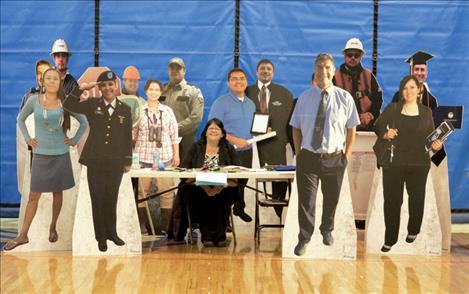Future workforce considers career options
Hey savvy news reader! Thanks for choosing local.
You are now reading
1 of 3 free articles.
ST. IGNATIUS – It’s a question that might take a lifetime to answer, but Mission High School students were asked to get started trying to decide what they want to be when they grow up. Dozens of professionals were brought into the school on Wednesday to share their experiences in the workforce to help students answer that question.
“I want to be police officer,” Sophomore Jeremiah Welch said. He listened to Highway Patrolman Jim Sanderson talk about what it takes to be an officer during a 30-minute workshop. Sergeant Sanderson said it’s a great job, but students should be prepared for one little thing.
“Every highway patrolman has been ‘tazed’, (as part of their training)” he said. He also recommended students acquire higher education and math skills. “You have to run calculations to determine speed,” he said of car accidents.
Senior Camaleigh Old Coyote explored a career related to environmental studies in another classroom. She found the workshop on hydrology to be helpful.
“I want to major in environmental studies with a minor in climate change,” she said, but she isn’t sure about a career yet. “I’m thinking about being a climate change analyst. I don’t know. There are so many routes I can take.”
In another classroom, Ryce Hegwood, 20, talked about what it’s like to be in college. He recently graduated from Mission. On his way to lunch, he explained some of the things he shared with the students including the benefits of learning time management skills.
“It’s up to you to decide what you want to do,” he said. “You can change your major as much as you want and try different things, but no one is holding your hand telling you what to do. Your parents might support you, but other than that, it’s up to you.”
Dr. LeeAnna Muzquiz introduced herself to a classroom of students as the medical director for Tribal Health. She explained that it took her a few years to decide to become a doctor, but life experiences helped her make the choice.
“I struggled my first semester,” she said of college. “My father had a heart attack, and a good friend was in a serious car accident.”
Her father never recovered from the heart attack.
“He passed away 25 years ago,” she said. “I took time off from college to figure out what I wanted to do. I thought about my dad. He was 44 when he died. I felt this was preventable. I used that to help me get back on track.”
Montana Rail Link Human Resources Director Pam Schneiter talked about jobs with the railroad. She recommended students not wear hats or chew gum during interviews. She was a good example of how people often change careers.
“I have a degree in elementary teaching, and I’m not teaching,” she said. “My point is that all education is valuable even if you end up changing careers. What you learn, you can always use in some way.”
Penny Kipp, scholarship coordinator for the Confederated Salish and Kootenai Tribes, set up her life-size images of professionals from across the reservation in the gym to show the different careers tribal members have found.
“I wanted to give the kids role models,” she said. “These are jobs the kids can have, too. We’ve got cops, teachers, principals, social workers, wildlife biologists, a professor and a lineman. We want kids to see that they can be anything.”
Senior Raymond Matt knows he is going to college to play football, but he is still considering a career. He said listening to different professionals gave him a few ideas.
“I haven’t found exactly what I want to do, but I’m going to keep trying different things,” he said. “We’ll find out what the future holds.”



















